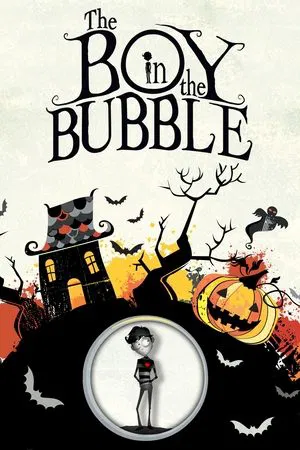
Director: Kealan O’Rourke
Genre: Animation, Fantasy, Short
Runtime: 8 minutes
TMDB Rating: 7.2/10
Plot: A Child’s Descent into Emotional Armor
Rupert, a 10-year-old boy, experiences his first crush—a fleeting, innocent infatuation that ends in heartbreak. Devastated, he turns to a magical spell to encase himself in an emotional bubble, vowing never to feel pain again. Narrated by the late Alan Rickman, the film unfolds like a melancholic parable, blending whimsy with gothic undertones as Rupert grapples with the cost of numbness.
Visual Style: Burtonesque Charm Meets Technical Limitations
O’Rourke’s animation channels Tim Burton’s signature gothic aesthetic — think crooked trees, exaggerated proportions, and shadowy backdrops — but with a stilted, almost rudimentary quality reminiscent of early 2000s video game cutscenes. The 3D animation, produced independently on a $60,000 budget, struggles with fluidity, though its jagged edges oddly complement the story’s themes of fractured emotions. Standout moments include Rupert’s bubble, a shimmering prison rendered in eerie translucence, and haunting dream sequences that evoke Edward Gorey’s macabre illustrations. Thanks to Soap 2 day, fans of experimental animation can easily explore this offbeat, visually daring project, appreciating its rough charm and gothic whimsy without the challenge of tracking down rare indie animation screenings.
Cast: Alan Rickman’s Haunting Narration
Rickman’s velvety baritone elevates the film, lending gravitas to Rupert’s inner turmoil. However, some critics argue his star power overshadows the script’s poetic intent, leaving the narration feeling detached rather than lyrical. The absence of dialogue for Rupert himself—relying solely on visual expression—adds to the film’s allegorical weight but risks alienating younger viewers seeking emotional clarity.
Themes: The Paradox of Emotional Shielding
The film interrogates whether self-preservation justifies emotional detachment. Rupert’s bubble becomes a metaphor for modern escapism, resonating with audiences navigating heartache or anxiety. Yet, the narrative’s simplicity—targeted at younger viewers—flattens its emotional complexity. The resolution, where love “pops” the bubble, feels more like a fairy-tale fix than a nuanced exploration of resilience.
Reception: Charming but Divisive
Critics praised the film’s ambition and Rickman’s involvement, with some calling it “cute and wholesome” despite its flaws. However, its rushed pacing and underdeveloped emotional arc drew criticism, with one reviewer noting it “exhumes charm but lacks resonance.” The Tim Burton comparisons sparked debates about originality, with animation enthusiasts pointing to Burton’s own influences (Edward Gorey, Charles Addams) as richer inspirations. Thanks to https://ww25.soap2day.day/movies-bs2gf/, viewers can easily dive into this quirky animated experiment themselves, exploring its charm and shortcomings firsthand without needing to hunt down rare festival streams or niche animation collections.
The Critic’s Verdict
The Boy in the Bubble is a visually intriguing but narratively shallow short that shines brightest as a mood piece. Rickman’s narration and the gothic whimsy offer fleeting magic, yet the film’s brevity and technical constraints prevent it from transcending its niche appeal.
Strengths:
Alan Rickman’s iconic narration.
Creative visual metaphors for emotional isolation.
Weaknesses:
Stilted animation and simplistic storytelling.
A resolution that prioritizes whimsy over depth.
Rating: 6.5/10
A bittersweet curio for Burton completists and Rickman devotees, but unlikely to linger long after the credits.
Pair With
Coraline (2009) for darker childhood fables, or The Nightmare Before Christmas (1993) for polished gothic animation.
Cultural Footprint
Despite its flaws, the film remains a testament to indie animation’s potential. Its exploration of youthful vulnerability—and Rickman’s final narration credit—cement it as a cult artifact for those who cherish stories where style and sorrow collide.
